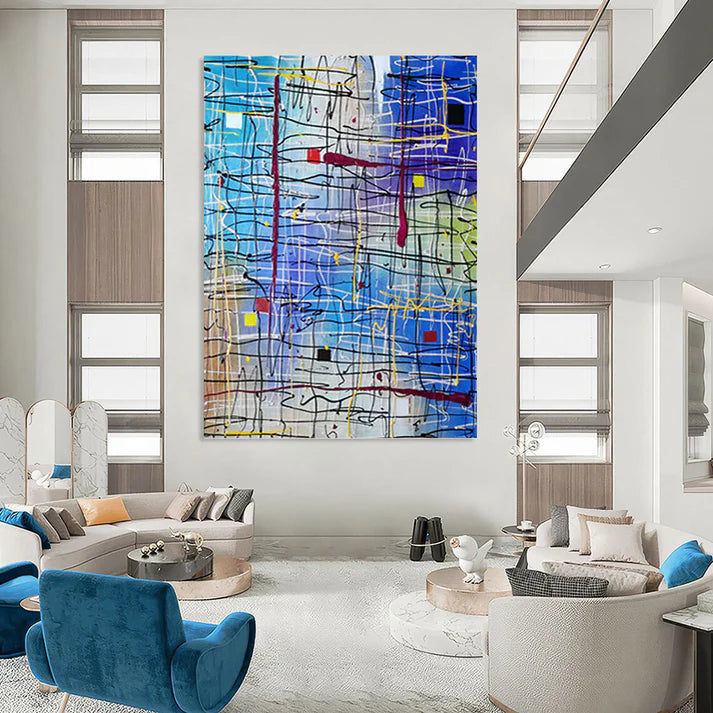Vibrant Line Fusion: A Harmonious Dance of Chaos and Creativity in Contemporary Art
Share
Vibrant Line Fusion is an exciting contemporary art form that blends dynamic lines with vivid colors, producing captivating compositions that balance chaos and harmony. Inspired by the recent article on Abstract XL’s blog, this article delves deeper into the essence of vibrant line fusion, unpacking its creative process, artistic significance, and its ability to invigorate modern spaces with energy and emotion.

The Essence of Vibrant Line Fusion
At its core, vibrant line fusion combines bold, kinetic lines with rich, saturated color palettes to create artworks that pulsate with life and motion. The technique often involves layering multiple lines—ranging from fluid curves to sharp zigzags—intersecting in unpredictable yet visually compelling ways. This approach reflects the juxtaposition of order and disorder, a central theme in artistic expression that invites viewers to find meaning in visual complexity.
Lines serve as the fundamental building blocks of this style. As explored in authoritative guides such as Number Analytics’ comprehensive overview of line art techniques, different line types—straight, curved, diagonal, zigzag, hatching—can convey a multitude of feelings and narratives. In vibrant line fusion, artists utilize these varied lines to generate texture, movement, and ecstatic rhythm.
Artistic Techniques and Tools
Artists working in vibrant line fusion often employ both traditional and digital media. Traditional tools like ink, acrylic paints, and pens enable expressive brushwork and layering effects, while digital tools like Adobe Illustrator and Procreate allow precise manipulation of line and color dynamics.
The creative process demands intuitive spontaneity alongside thoughtful composition. Artists interweave lines of different weights, lengths, and directions, sometimes incorporating interrupted or chaotic lines to symbolize emotional turbulence or complexity, as detailed in art discussions on line types by Debasree Dey Art.
Color theory plays a vital role. Vibrant hues contrast with dark outlines to intensify visual impact and guide the viewer's eye across the canvas. The strategic balance of chaos—through energetic, intersecting lines—and harmony—through coordinated colors and repeated motifs—creates a mesmerizing tension that defines the genre.
The Emotional and Visual Impact
Vibrant line fusion appeals strongly to contemporary audiences seeking artwork that conveys both depth and vitality. Its layered complexity encourages prolonged viewing, as each line and color shift reveals new relationships and meanings. This art form manifests the universal human experience: the coexistence of disorder and order, uncertainty and balance.
Moreover, vibrant line fusion lends itself beautifully to modern interior spaces. According to We Art Online, vibrant artworks can energize minimalistic environments, injecting personality without overwhelming simplicity. The vibrant colors and active lines visually animate rooms, making the artworks ideal for both homes and commercial settings.
Influences and Historical Roots
While distinctly contemporary, vibrant line fusion draws inspiration from earlier art movements. Abstract expressionism’s emphasis on spontaneous, gestural brushwork and the rhythmic patterns seen in certain folk arts resonate within this style. The interplay of chaos and order also echoes philosophical themes explored in avant-garde art.
Artists like Henri Matisse famously remarked on the power of the line as a visual and emotional vehicle—"The line is a dot that went for a walk"—a poetic encapsulation of what vibrant line fusion expresses through continuous, purposeful motion.
Frequently Asked Questions (FAQ)
Q: What is vibrant line fusion in art?
A: It is a contemporary abstract style combining dynamic lines and vivid colors to create engaging, rhythmic compositions full of movement and energy.
Q: Which line types are frequently used in vibrant line fusion?
A: Artists use a variety of lines including curved, zigzag, diagonal, and hatching lines to build texture, tension, and visual interest.
Q: Can vibrant line fusion artworks suit modern home decor?
A: Yes, their energetic colors and bold lines complement minimalist and contemporary interiors by adding vitality without clutter.
Q: What tools do artists use for line fusion art?
A: Both traditional media such as ink and acrylics and digital tools like Adobe Illustrator and Procreate are popular choices.
Q: Where can I learn more about line art techniques?
A: Resources like Number Analytics’ guide and Debasree Dey Art provide detailed insights.
Vibrant line fusion continues to evolve as a compelling art form, reflecting the beautiful complexity of life itself through the universal language of line and color. Its harmonious chaos invites us to look closer, experience deeper, and embrace the joyful unpredictability of creativity.
For a detailed exploration of vibrant line fusion, visit the full article on Abstract XL’s blog.



